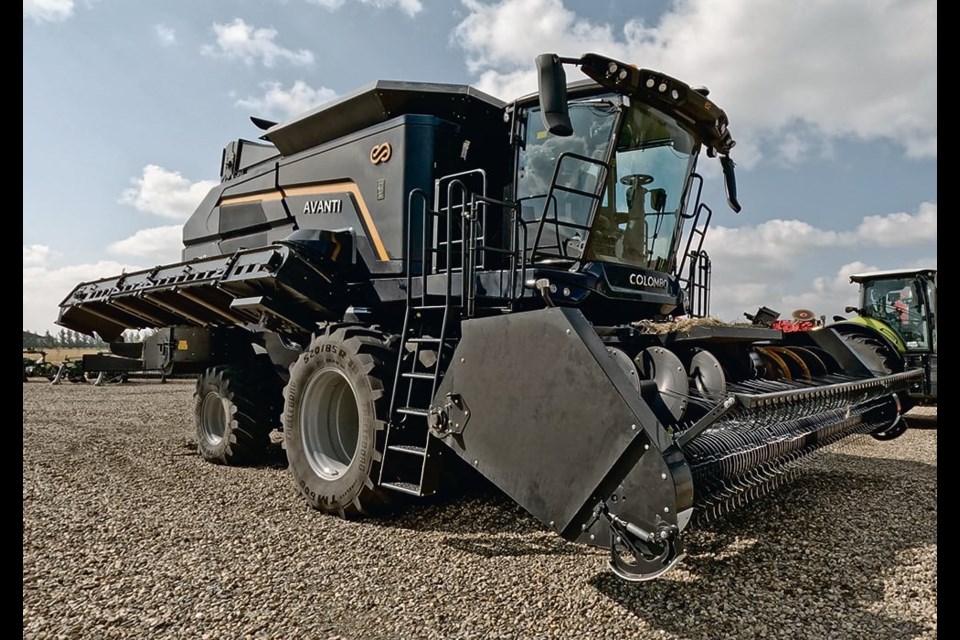WESTERN PRODUCER — Growers want their crops harvested in the best possible condition, and for edible beans especially, that means careful threshing to avoid shattering or cracking, both of which can significantly reduce value.
“Quality is huge,” says Frank Unger, a salesperson at genAG equipment in Winkler, Man., which sells and services Colombo brand bean harvesters from Brazil.
“An edible bean cannot be cracked or blemished. The end buyer wants good quality. A broken or cracked bean turns into jelly in the can.”
Having the right harvester can make the difference.
One of Unger’s customers, the Blumengart Colony near Plum Coulee, Man., has become the first Canadian grower to take delivery of a new Colombo Avanti self-propelled bean combine. Until now, only the company’s pull-type harvesters were sold in Canada.
“They’ve been building these combines for seven years,” said Unger of the Avanti model. “Colombo has been in the business for 50 years. This combine was originally designed for the peanut market.”
Most of the brand’s North American dealerships are in the southern United States, but Unger believes the Avanti is also suited to edible bean production in southern Manitoba and elsewhere.
“With these machines, we find up to less than one percent dockage for cracked,” Unger said. “The threshing system is designed to be a little more gentle. It isn’t a rasp bar like grain-on-grain harvesting. It’s a twin rotor that has flighting on it and threshing pins, we call them. You can adjust the pins to how aggressive you want it to be.”
Behind the rotors, a shaker deck moves material toward the rear of the combine, while beans fall through grates onto a cross auger that lifts them into the hopper. Rear-mounted fans pull chaff and debris out.
Compared to the pull-type models built by Colombo, the Avanti offers a big jump in productivity and sample quality.
“From the pull-type, it has about 30 percent more threshing capacity,” he added. “But it has a lot more cleaning power so there aren’t as many damaged beans coming off this combine versus a pull-type. The self-propelled is larger, longer and has more capacity.”
Mark Tschetter of the Blumengart Colony said they’ve harvested about 1,500 acres with the Avanti so far this year, and that it can cover about one and a half times as many acres per hour than the brand’s pull-type model.
He said they’ve used an ordinary grain combine to harvest beans, but it results in much higher crop damage. Also, if crop moisture is high, damaged beans can pack into several areas, plugging up systems and causing hours of downtime.
Tschetter said the Avanti performed best when it was kept fully fed and running at capacity. The colony has been picking up a 60-foot swath with it. But that has pushed the Deere engine to its limit.
Power comes from the same nine-litre PowerTech diesel John Deere uses in its 8 Series tractors. Like a typical combine, the engine is mounted up top at the rear. Drive gets routed through a three-range hydrostatic Claas transmission.
“It’s all hydraulically driven,” said Unger. “So you can adjust every function from the header right up to the sieves, the elevator or the fans. You can adjust it all from the cab.”
An in-cab monitor shows images from four cameras mounted throughout the threshing system.
The cab is built by Claas, too, and makes for familiar surroundings for anyone who has operated a standard grain combine.
“It’s very comfortable and quiet,” said Unger.
Colombo has its own telematics system that provides typical machine data transmission and a Raven GPS system is standard equipment.
Tschetter said the farm hasn’t yet paid much attention to the telematics package. So far, they’ve been mainly concerned with evaluating the Avanti’s threshing performance, as has the dealership and the brand’s engineering staff.
“From 小蓝视频 America to here, our conditions are very different,” said Unger. “(Colombo) engineers are here right now. They’ve been here all season. They’re watching this combine like a hawk.”
Final evaluations of the Avanti’s performance this season could determine if any changes are made to future models sold here.
Bookmark SASKTODAY.ca, Saskatchewan's home page, at this link.




